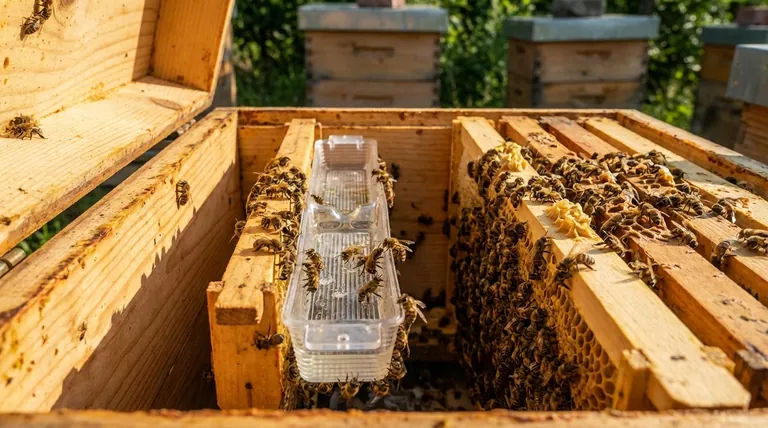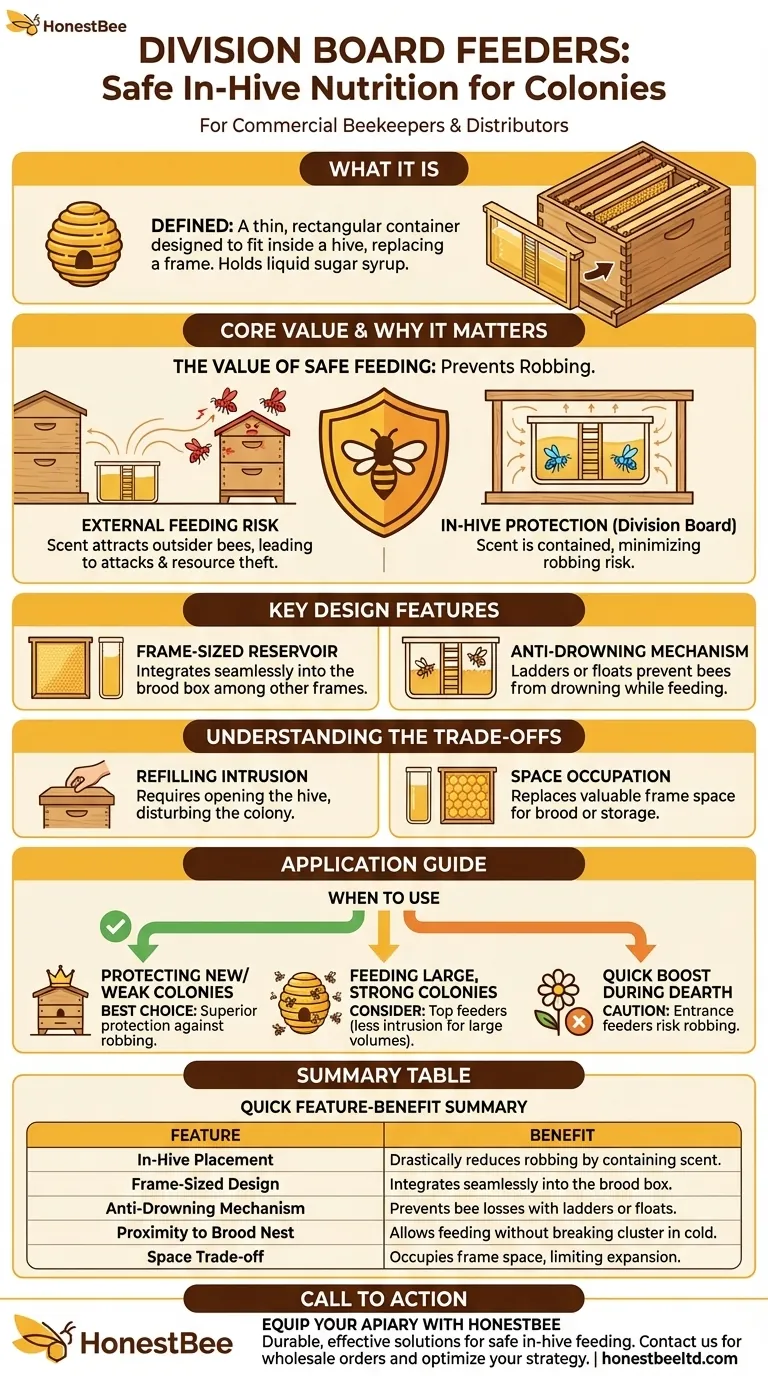In short, a division board feeder is a thin, rectangular container designed to fit inside a bee hive, taking the place of one or two frames. Its purpose is to hold liquid sugar syrup, providing a direct and protected food source for the colony, especially during times when natural nectar is scarce.
The core value of a division board feeder isn't just feeding the bees; it's about feeding them safely. By placing the food source entirely within the hive, it dramatically reduces the risk of "robbing," where bees from stronger hives attack and steal resources from weaker ones.

Why In-Hive Feeding is a Critical Strategy
A beekeeper’s primary goal is to ensure the colony has the resources it needs to thrive. Supplemental feeding is often necessary, but how you feed can be as important as what you feed.
Protecting the Colony from Robbing
Robbing is a major threat, especially for new or weak colonies. When food sources are placed outside the hive, the scent can attract bees from other hives in the area.
This can trigger a frenzy where the stronger colonies overwhelm the weaker one, stealing its food and often killing the queen and bees in the process.
A division board feeder contains the syrup entirely within the hive walls. This minimizes the scent that escapes, making it nearly impossible for outside bees to locate and instigate robbing.
Ensuring Efficient Access for Bees
Placing the feeder directly next to the brood nest means the bees don't have to travel far or leave the hive for food.
This is especially crucial during colder weather when bees are clustered together for warmth. They can access the food without breaking their cluster and risking exposure.
Key Design Features
The effectiveness of a division board feeder comes down to a few simple but brilliant design elements that solve specific beekeeping challenges.
The Frame-Sized Reservoir
The feeder is built to the same dimensions as a standard hive frame (e.g., a Langstroth deep or medium frame).
This allows it to be slotted directly into the hive body among the other frames, integrating seamlessly into the bees' living space without extra equipment.
The Anti-Drowning Mechanism
A significant risk with any liquid feeder is bees drowning in the syrup. To prevent this, division board feeders incorporate a safety feature.
This is often a plastic ladder, a textured interior wall, or a wooden float that sits on the syrup's surface, giving the bees a safe place to stand while they feed.
Understanding the Trade-offs
While highly effective, division board feeders are not without their limitations. Objectivity requires understanding both their strengths and weaknesses.
Refilling Requires Hive Intrusion
To refill the feeder, you must open the hive. This disturbs the colony and exposes it to the elements.
This is in contrast to external feeders (like entrance or top feeders) that can often be refilled with minimal disturbance.
It Occupies Valuable Space
The feeder takes the place of one or two frames. This is space that the bees could otherwise use to build comb for raising brood or storing their own honey and pollen.
For a rapidly expanding colony, this trade-off between feeding and growth space must be carefully considered.
How to Apply This to Your Hive
Choosing the right feeder depends entirely on your colony's specific situation and your management goals.
- If your primary focus is protecting a new or weak colony: The division board feeder is your best choice due to its superior protection against robbing.
- If your primary focus is feeding a large, strong colony with minimal disturbance: An external top feeder might be more efficient, as it holds more volume and can be refilled without opening the brood box.
- If your primary focus is providing a quick, temporary boost during a nectar dearth: An entrance feeder can work, but you must be vigilant about the risk of robbing.
Ultimately, the division board feeder is an essential tool for providing targeted, protected nourishment when your colony needs it most.
Summary Table:
| Feature | Benefit for Beekeepers |
|---|---|
| In-Hive Placement | Drastically reduces robbing by containing food scent. |
| Frame-Sized Design | Integrates seamlessly into the brood box. |
| Anti-Drowning Mechanism | Prevents bee losses with ladders or floats. |
| Proximity to Brood Nest | Allows bees to feed without breaking cluster in cold weather. |
| Space Trade-off | Occupies frame space, which can limit colony expansion. |
Equip your apiary with the right tools for success.
At HONESTBEE, we understand that protecting your investment starts with reliable equipment. Our division board feeders are designed with the commercial beekeeper and distributor in mind, offering durable, effective solutions for safe in-hive feeding.
Let us help you safeguard your colonies and optimize your feeding strategy. We supply a full range of high-quality beekeeping supplies and equipment through our wholesale-focused operations.
Contact HONESTBEE today to discuss your needs and place your wholesale order.
Visual Guide

Related Products
- In-Hive Dual Compartment Frame Bee Feeder for Targeted Colony Nutrition
- Classic Boardman Entrance Bee Feeder Hive Front Feeding Solution
- Professional In-Hive Frame Bee Feeder by HONESTBEE
- Boardman Entrance Bee Feeder Durable Galvanized Steel and Wood Construction for Beekeeping
- Professional Hive Top Bee Feeder for Beekeeping
People Also Ask
- Are frame feeders good? Maximize Your Hive's Health with the Right Feeding Strategy
- When is sugar syrup typically fed to bees? A Guide to Strategic Feeding for Strong Hives
- What are frame feeders, and what are their advantages? Essential for Cold Weather & Efficient Feeding
- What strategy was used to eliminate summer migration in the Sierra foothills? Proactive Feeding Based on Brood Signals
- What precautions should be taken when feeding bees inside the hive? Safeguard Your Colony from Robbing and Leaks



















